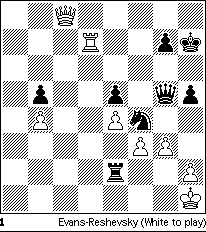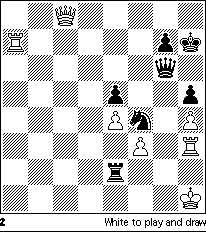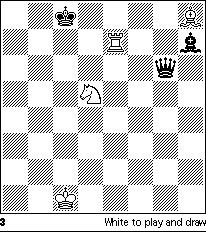
Endgame Explorations 1: An Introduction
Noam Elkies
Editor's note: This issue we introduce a new column to Chess Horizons readers. Mathematician, musician and chessmaster Noam Elkies is a member of Harvard University's Society of Fellows and an internationally known endgame composer whose works have received numerous awards. Each issue Elkies will illustrate a new theme from the beautiful world of studies.
Thanks to Christopher Chabris and the Chess Horizons staff for inviting me to contribute a regular column devoted to the art of the composed endgame. Each article appearing in this space will explore one of the ideas and themes that inspire endgames' authors and enchant their solvers. Since many of these ideas originate in practical play, a combination from an actual game will often introduce a new concept; but we shall always emphasize not the mental struggle between two particular chessplayers, but the beautiful ideas this struggle leads them to create, and the polished form these ideas take in composed studies. I hope that this will lead the reader to a better appreciation of the composed endgame, and perhaps even encourage the reader to make his or her own original contribution to the art!
Before we get to the actual positions, though, it seems appropriate in this first article of the series to define the subject and answer a few common questions about it.
By an endgame I shall mean any legal chess position with the stipulation that White is to play and force a win or draw against best Black play; such a winning (or drawing) line is a solution to the endgame. The solution need only reach a theoretical win or draw-- the actual checkmate (or stalemate or perpetual check) need not be demonstrated. Endgames are not to be confused with chess problems, positions that are (usually) clearly won for White but stipulate mate in a fixed number of moves. These problems, and more exotic species such as helpmates (in which both sides cooperate to produce a mating position) or selfmates (wherein White forces Black to checkmate him against Black's will), will not concern us here. Composed endgame positions (also known as studies) are often, but not always, similar in appearance to positions typical of the final stage of a chess game, whence their name; but the solutions of composed endgames are more clear-cut and generally more tactical than the analysis of their real-life counterparts.
Will studying composed endgames improve your tournament performance? Not directly; while it is as important for the tournament player to play the final stage of the game well as it is to know opening lines and middlegame plans, composed endgames are far from a representative cross-section of the kind of position likely to arise in over-the-board play. This is because, while art imitates life, it is not bound by life; endgame composers love to construct ordinary-looking positions that conceal special effects, such as underpromotions or unusual sacrifices, that only rarely affect over-the-board endings. While it is true that endgame aficionados occasionally apply a study idea to a tournament game, I believe that the most significant contribution that a careful analysis of composed studies can make to your over-the-board play is through improved analytic depth and accuracy, skills crucial for all stages of the game.
Why, then, should the practical chessplayer spend time on these composed studies when he or she could be doing something more directly useful like learning some opening lines or improving his or her rook-ending technique? I believe this question misses the point. I ask instead: why, indeed, do we play chess at all when most of us will never earn enough at it to justify such difficult work? Because, of course, chess is not only hard work but can also be great fun-- and the fun comes not only from doing well on the scoreboard, but much more importantly from the action on the chessboard: the new opening innovation or trap, the profound strategic plan or brilliant combination in the middlegame, the tenacious defense or precise winning maneuver in the ending. Most of us will never pull of an Immortal Game or Evergreen Partie, so we glory in our small triumphs while sharing vicariously the exhilaration of the great masters' exploits.
But even GMs can only realize those combinations that their opponents permit, and only rarely will an OTB brilliancy appear in its best possible form. Consider, for instance, the conclusion of the game Evans-Reshevsky from the 1964 U. S. Championship, which came to be known as the "Swindle of the Century":

Evans, down a piece and threatened with 48 ... Re1#, tried 48 h4! tempting Reshevsky into 48 ... Qxg3?? Evans thereupon forced a draw with 49 Qg8+!! Kxg8 50 Rxg7+! If either the Black king or queen takes the rook, White is stalemated, but if Black refuses the rook, White keeps on checking from the 7th rank until Black concedes a perpetual or allows the stalemate.
A beautiful idea, but in a presentation far from ideal. For one thing, the "Swindle" part of the name indicates that Evans could only achieve this conclusion thanks to the gross blunder 48 ... Qxg3?? by his opponent-- after 48 ... Qf6! 49 Rd8 Ng6 White could resign. (The "Century" part also tells us something: this kind of resource is very rare in practical play. Not, however, literally once in a hundred years-- recall that Reshevsky fell into a similar trap against Pilnik only a few years earlier, a trap that also became known as the "Swindle of the Century" for a while; the even more impressive stalemate swindle of Beliavsky-Christiansen, Reggio Emilia 1987-88 now seems destined for the same title.) For another, after 48 ... Qxg3?? Evans could also have drawn by 49 Qg8+! (or 49 Qh8+!) Kxg8 50 Rd8+ leading to the same conclusion of stalemate or perpetual check by the desperado rook, so the drawing line is not unique. Lastly, the b-pawns are superfluous, since the entire combination works just as well without them. Let us try to fix those flaws:

1 Rg3!
1 Qf5 Nxh3! wins, and else 1 ... Qg2 or 1 ... Re1 mates.
1 ... Qxg3
1 ... Re1+ 2 Kh2 Rh1+ 3 Kxh1 Qxg3 ruins the stalemate, but after 4 Qf5+ White has nothing to worry about.
2 Qg8+! Kxg8 3 Rxg7+!
Draw. The perpetual can be escaped only through stalemate.
So we have made the solution sound (unlike Evans-Reshevsky, the draw is forced)and unique (since by removing the extraneous b-pawns, we've prevented 2 Qg8+ Kxg8 (or 2 Qh8+ Kxh8) 3 Ra8+!? because then the Black King ultimately escapes to f2). But there's more to endgame composition than mere soundness and uniqueness. The position is still cluttered with heavy artillery, the solution is short and transparent. Observe how the same idea is treated in a composed endgame:

This miniature (a study with 7 or fewer pieces) by B.G. Olympiev won 2nd Honorable Mention in the 1982 L'Italia Scacchistica tourney. It's hard to imagine a stalemate conclusion in this open position even once the theme is known, and indeed White starts by feigning a mating attack.
1 Rc7+
The threat of 1 ... Qc2# and White's many loose pieces force him to take positive action.
1 ... Kb8!
If 1 ... Kd8 2 Bf6+ Ke8 3 Re7+ Kf8 4 Bg7+ and Black must bail out with 4 ... Qxg7 because 4 ... Kg8?? 5 Nf6+ wins!
2 Be5!
White can afford a quiet move now that c2 is covered.
2 ... Ka8!
White would draw easily after 2 ... Qg1+ 3 Kb2 Ka8 4 Rxh7 or 2 ... Qb1+ 3 Kd2 Ka8 4 Rc8+.
3 Nb6+! Qxb6 4 Rc8+!
4 Rxh7? Qe3+ soon wins the rook.
4 ... Ka7!
4 ... Kb7 5 Rb8+ draws.
5 Bd4! Qxd4
The point of the sacrifices. White's king is stalemated, so it remains only to jettison the rook safely to secure the draw.
6 Ra8+!
White must be careful. 6 Rc7+? Ka6 7 Rc6+ Kb5 wins, since after 8 Rc5+ (or 8 Rb6+) Qxc5! the stalemate is destroyed.
6 ... Kb6 7 Rb8+ Kc5 8 Rc8+ and draws.
White will check from a8, b8 and c8 until Black plays either Kc3 (c4) allowing Rb3 (b4)+, Kd5 (d6,d7) allowing Rd8+, or captures the rook with stalemate.
Note how far we've come from Diagram 1 to Diagram 3: with far fewer pieces, Olympiev has created a long and varied combination leading up to a surprising stalemate conclusion (one that Kasparov might have liked to know before his debacle against Georgiev in the World Blitz Championship!) In future columns we'll follow similar transformations of diverse themes such as zugzwang, underpromotion, and positional draw. I hope the readers will enjoy our exploration of these beautiful exemplars of the inexhaustible variety of chess.
Noam Elkies is now Professor of Mathematics at Harvard University and is the author of "Chess Art in the Computer Age," published in ACJ 2 (1993). This article originally appeared in Chess Horizons.Next column: Perpetual Attack.
This page last modified on
28 April 2018.
Copyright (c) 1995-2018 Christopher F. Chabris. All rights
reserved.



